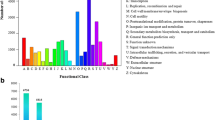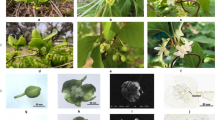Abstract
Garden asparagus (Asparagus officinalis L.) is a dioecious species whose male and female flowers are found in separate unisexual individuals. A region called the M-locus, located on a pair of homomorphic sex chromosomes, controls sexual dimorphism in asparagus. To date, no sex determining gene has been isolated from asparagus. To identify more genes involved in flower development in asparagus, subtractive hybridization library of male flowers in asparagus was constructed by suppression subtraction hybridization. A total of 107 expressed sequence tags (ESTs) were identified. BLASTX analysis showed that the library contained several genes that could be related to flower development. The expression patterns of seven selected genes believed to be involved in the development of asparagus male flower were further analyzed by semi-quantitative or real-time reverse-transcription polymerase chain reaction (RT-PCR). Results showed that AOEST 4-5, AOEST 12-40, and AOEST 13-38 were strongly expressed in the male flower stage, whereas no transcript level of AOEST 13-38 was detected in the female flower stage. The expression levels of AOEST 13-87, AOEST 13-92, AOEST 13-40, and AOEST 18-87 in the male flower stage were also higher than those in the female flower stage, although these transcripts were also expressed in other tissues. The identified genes can provide a strong starting point for further studies on the underlying molecular differences between the male and female flowers of asparagus.




Similar content being viewed by others
Abbreviations
- SSH:
-
Suppression subtraction hybridization
- ESTs:
-
Expressed sequence tags
- RT-PCR:
-
Reverse-transcription polymerase chain reaction
- DIG:
-
Digoxigenin
- RTs:
-
Reverse transcriptions
- GO:
-
Gene ontology
- SqPCR:
-
Semi-quantitative RT-PCR
- qRCR:
-
Quantitative PCR
- PCD:
-
Programmed cell death
- Tdr:
-
Tapetum degeneration retardation
- MFB:
-
Male flower bud
- MF:
-
Male flower
- MP:
-
Male phylloclade
- MS:
-
Male stem
- MR:
-
Male root
- FFB:
-
Female flower bud
- FF:
-
Female flower
- FP:
-
Female phylloclade
- FS:
-
Female stem
- FR:
-
Female root
References
Aarts MG, Keijzer CJ, Stiekema WJ, Pereira A (1995) Molecular characterization of the CER1 gene of Arabidopsis involved in epicuticular wax biosynthesis and pollen fertility. Plant Cell 7:2115–2127
Ariizumi T, Amagai M, Shibata D, Hatakeyama K, Watanabe M, Toriyama K (2002) Comparative study of promoter activity of three anther-specific genes encoding lipid transfer protein, xyloglucan endotransglucosylase/hydrolase and polygalacturonase in transgenic Arabidopsis thaliana. Plant Cell Rep 21:90–96
Biffi R, Restivo FM, Tassi F, Caporali E, Carboni A, Marziani GP, Spada A, Falavigna A (1995) A restriction fragment length polymorphism probe for early diagnosis of gender in Asparagus officinalis L. HortScience 30:1463–1464
Botton A, Begheldo M, Rasori A, Bonghi C, Tonutti P (2002) Differential expression of two lipid transfer protein genes in reproductive organs of peach (Prunus persica L. Batsch). Plant Sci 163:993–1000
Caporali E, Carboni A, Galli MG, Rossi G, Spada A, Marziani Longo GP (1994) Development of male and female flower in Asparagus officinalis. Search for point of transition from hermaphroditic to unisexual developmental pathway. Sex Plant Reprod 7:239–249
Caporali E, Spada A, Losa A, Marziani G (2000) The MADS box gene AOM1 is expressed in reproductive meristems and flowers of the dioecious species Asparagus officinalis. Sex Plant Reprod 13:151–156
Clauß K, Baumert A, Nimtz M, Milkowski C, Strack D (2008) Role of a GDSL lipase-like protein as sinapine esterase in Brassicaceae. Plant J 53:802–813
Diatchenko L, Lau YF, Campbell AP, Chenchik A, Moqadam F, Huang B, Lukyanov S, Lukyanov K, Gurskaya N, Sverdlov ED, Siebert PD (1996) Suppression subtractive hybridization: a method for generating differentially regulated or tissue-specific cDNA probes and libraries. Proc Natl Acad Sci 93:6025–6030
Edstam MM, Viitanen L, Salminen TA, Edqvist J (2011) Evolutionary history of the non-specific lipid transfer proteins. Mol Plant 4:947–964
Fernandez L, Torregrosa L, Terrier N, Sreekantan L, Grimplet J, Davies C, Thomas MR, Romieu C, Ageorges A (2007) Identification of genes associated with flesh morphogenesis during grapevine fruit development. Plant Mol Biol 63:307–323
Fiebig A, Mayfield JA, Miley NL, Chau S, Fischer R, Preuss D (2000) Alterations in CER6, a gene identical to CUT1, differentially affect long-chain lipid content on the surface of pollen and stems. Plant Cell 12:2001–2008
Flory WS (1932) Genetic and cytological investigations on Asparagus officinalis L. Genet Princeton 17:432–467
Gao WJ, Li SF, Zhang GJ, Wang NN, Deng CL, Lu LD (2013) Comparative analysis of gene expression by microarray analysis of male and female flowers of Asparagus officinalis. Biosci Biotech Bioch 77:1193–1199
Gebler P, Wolko L, Knaflewski M (2007) Identification of molecular markers for selection of supermale (YY) asparagus plants. J Appl Genet 48:129–131
Harada T, Torii Y, Morita S, Masumura T, Satoh S (2010) Differential expression of genes identified by suppression subtractive hybridization in petals of opening carnation flowers. J Exp Bot 61:2345–2354
Jamsari A, Nitz I, Reamon-Büttner SM, Jung C (2004) BAC-derived diagnostic markers for sex determination in asparagus. Theor Appl Genet 108:1140–1146
Kanno A, Hienuki H, Ito T, Nakamura T, Fukuda T, Yun PY, Song IJ, Kamimura T, Ochiai T, Yokoyama J, Maki M, Kameya T (2006) The structure and expression of SEPALLATA-like genes in Asparagus species (Asparagaceae). Sex Plant Reprod 19:133–144
Kanno A, Kubota S, Ishino K (2014) Conversion of a male-specific RAPD marker into an STS marker in Asparagus officinalis L. Euphytica 197:39–46
Kazama Y, Fujiwara MT, Koizumi A, Nishihara K, Nishiyama R, Kifune E, Abe T, Kawano S (2009) A SUPERMAN-like gene is exclusively expressed in female flowers of the dioecious plant Silene latifolia. Plant Cell Physiol 50:1127–1141
Li N, Zhang DS, Liu HS, Yin CS, Li XX, Liang WQ, Yuan Z, Xu B, Chu HW, Wang J, Wen TQ, Huang H, Luo D, Ma H, Zhang DB (2006) The rice tapetum degeneration retardation gene is required for tapetum degradation and anther development. Plant Cell 18:2999–3014
Ling H, Zhao J, Zuo K, Qiu C, Yao H, Qin J, Sun X, Tang K (2006) Isolation and expression analysis of a GDSL-like lipase gene from Brassica napus L. J Biochem Mol Biol 39:297–303
Livak KJ, Schmittgen TD (2001) Analysis of relative gene expression data using real-time quantitative PCR and the 2-ΔΔCT method. Methods 25:402–408
Löptien H (1979) Identification of the sex chromosome pair in asparagus (Asparagus officinalis L.). Z Pfanzenzüchtg 82:162–173
Losa A, Caporali E, Spada A, Martinelli S, Marziani G (2004) AOM3 and AOM4: two MADS box genes expressed in reproductive structures of Asparagus officinalis. Sex Plant Reprod 16:215–221
Lu LD, Li RL, Gao WJ, Deng CL, Wang LJ (2006) Cloning and analyzing of the female—specific marker in the dioecious species Asparagus officinalis L. J Mol Cell Biol 39:281–284 (in Chinese)
Ma GY, Ning GG, Pang RH, Zhan J, Li X, Zhang W, Bao MZ (2011) Analysis of Petunia hybrida double flower transcriptome suing suppression subtractive hybridization. Sci Hortic-Amsterdam 127:398–404
Miao HX, Qin YH, da Silva JAT, Ye ZX, Hu GB (2013) Identification of differentially expressed genes in pistils from self-incompatible Citrus reticulata by suppression subtractive hybridization. Mol Biol Rep 40:159–169
Müller GL, Drincovich MF, Andreo CS, Lara MV (2010) Role of photosynthesis and analysis of key enzymes involved in primary metabolism throughout the lifespan of the tobacco flower. J Exp Bot 61:3675–3688
Nakayama H, Ito T, Hayashi Y, Sonoda T, Fukuda T, Ochiai T, Kameya T, Kanno A (2006) Development of sex-linked primers in garden asparagus (Asparagus officinalis L.). Breeding Sci 56:327–330
Namasivayam P, Hanke D (2006) Identification of differentially expressed sequences in pre-embryogenic tissue of oilseed rape by suppression subtractive hybridisation (SSH). Plant Cell Tiss Org 86:417–421
Pang RH, Ma GY, Lou XY, Bao MZ, Ye YM (2012) Construction and analysis of suppression subtractive cDNA library from fertile disk floret buds of Zinnia elegans. J Integr Agr 11:567–575
Park JH, Ishikawa Y, Yoshida R, Kanno A, Kameya T (2003) Expression of AODEF, a B-functional MADS-box gene, in stamens and inner tepals of the dioecious species Asparagus officinalis L. Plant Mol Biol 51:867–875
Park JH, Ishikawa Y, Ochiai T, Kanno A, Kameya T (2004) Two GLOBOSA-like genes are expressed in second and third whorls of homochlamydeous flowers in Asparagus officinalis L. Plant Cell Physiol 45:325–332
Reamon-Büttner SM, Jung C (2000) AFLP-derived STS markers for the identification of sex in Asparagus officinalis L. Theor Appl Genet 100:432–438
Reamon-Büttner SM, Schondelmaier J, Jung C (1998) AFLP markers tightly linked to the sex locus in Asparagus officinalis L. Mol Breeding 4:91–98
Sonoda T, Iwamura H, Uragami A, Ohwada M (2003) Development of a rapid method for identifying asparagus super-males using N-(4-chloro-2-trifluoromethylphenyl)-N’-propoxyacet-amidine to induce flowering. Euphytica 129:169–174
Spada A, Caporali E, Marziani G, Portaluppi P, Restivo FM, Tassi F, Falavigna A (1998) A genetic map of Asparagus officinalis based on integrated RFLP, RAPD and AFLP molecular markers. Theor Appl Genet 97:1083–1089
Telgmann-Rauber A, Jamsari A, Kinney MS, Pires JC, Jung C (2007) Genetic and physical maps around the sex-determining M-locus of the dioecious plant asparagus. Mol Genet Genomics 278:221–234
Terefe D, Tatlioglu T (2005) Isolation of a partial sequence of a putative nucleotide sugar epimerase, which may involve in stamen development in cucumber (Cucumis sativus L.). Theor Appl Genet 111:1300–1307
Thoma S, Hecht U, Kippers A, Botella J, De Vries S, Somerville C (1994) Tissue-specific expression of a gene encoding a cell wall localized lipid transfer protein from Arabidopsis. Plant Physiol 105:35–45
Tsuwamoto R, Fukuoka H, Takahata Y (2007) Identification and characterization of genes expressed in early embryogenesis from microspores of Brassica napus. Planta 225:641–652
Uno Y (2002) Haploid production from polyembryonic seeds of Asparagus officinalis L. Acta Hort (ISHS) 589:217–221
Yun PY, Ito T, Kim SY, Kanno A, Kameya T (2004) The AVAG1 gene is involved in development of reproductive organs in the ornamental asparagus, Asparagus virgatus. Sex Plant Reprod 17:1–8
Zeigerer A, Gilleron J, Bogorad RL, Marsico G, Nonaka H, Seifert S, Epstein-Barash H, Kuchimanchi S, Peng CG, Ruda VM, Conte-Zerial PD, Hengstler JG, Kalaidzidis Y, Koteliansky V, Zerial M (2012) Rab5 is necessary for the biogenesis of the endolysosomal system in vivo. Nature 485:465–470
Zhang D, Liang W, Yin C, Zong J, Gu F, Zhang D (2010) OsC6, encoding a lipid transfer protein, is required for postmeiotic anther development in rice. Plant Physiol 154:149–162
Acknowledgments
The research was supported by grants from the National Natural Science Foundation of China (31000165, 31300202) and Program for Innovative Research Team (in Science and Technology) in University of Henan Province (15IRTSTHN020).
Author information
Authors and Affiliations
Corresponding author
Electronic supplementary material
Below is the link to the electronic supplementary material.
10265_2015_735_MOESM1_ESM.tif
Fig. S1 PCR analysis of adaptor ligation efficiency. Lane 1: PCR products using Tester 1-1(Adaptor 1-ligated) as the template and the SLactin 3′Primer and PCR Primer 1. Lane 2: PCR products using Tester (male flower buds cDNA) 1-1(Adaptor 1-ligated) as the template, and the SLactin 3′ and 5′ Primers. Lane 3: PCR products using Tester (male flower buds cDNA) 1-2(Adaptor 2R-ligated) as the template, and the SLactin 3′ Primer and PCR Primer 1. Lane 4: PCR products using Tester (male flower buds cDNA) 1-2(Adaptor 2R-ligated) as the template, and the SLactin 3′ and 5′ Primers. Lane M: 400, 500, 600 bp (TIFF 646 kb)
10265_2015_735_MOESM2_ESM.tif
Fig. S2 Analysis of subtraction efficiency by polymerase chain reaction (PCR). PCR was performed on the unsubtracted (lanes 1–4) or subtracted (lanes 5–8) secondary PCR product using the SLactin 5′ and 3′ primers. Lanes 1 and 5: 30 cycles; lanes 2 and 6: 25 cycles; lanes 3 and 7: 20 cycles; lanes 4 and 8: 15 cycles. Lane M: 300, 400, 500 bp (TIFF 888 kb)
10265_2015_735_MOESM6_ESM.doc
Table S3 tBLASTx analysis for part of sequenced differentially expressed cDNA clones from male subtracted cDNA library (DOC 77 kb)
Rights and permissions
About this article
Cite this article
Deng, Cl., Wang, Nn., Li, Sf. et al. Isolation of differentially expressed sex genes in garden asparagus using suppression subtractive hybridization. J Plant Res 128, 829–838 (2015). https://doi.org/10.1007/s10265-015-0735-6
Received:
Accepted:
Published:
Issue Date:
DOI: https://doi.org/10.1007/s10265-015-0735-6




